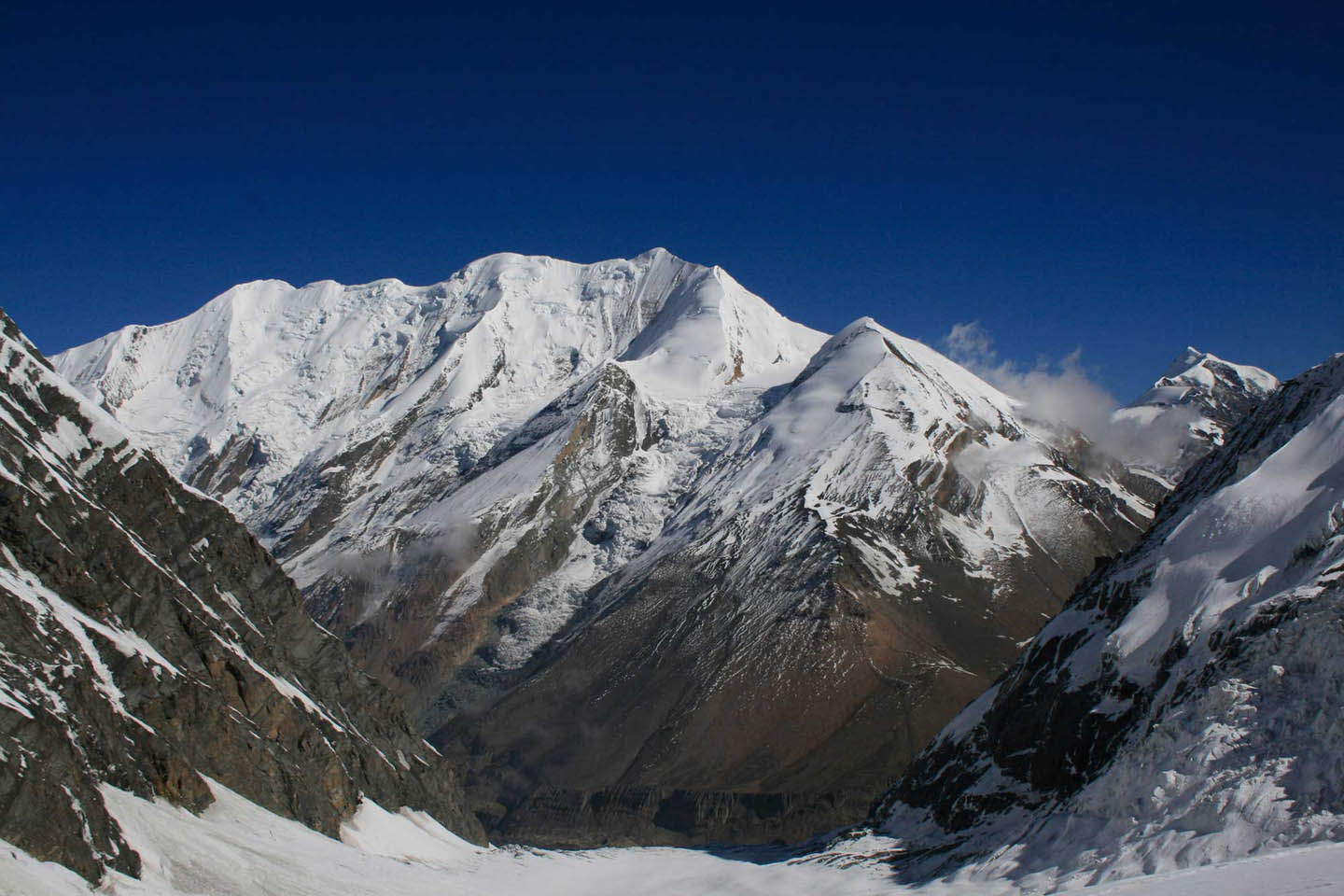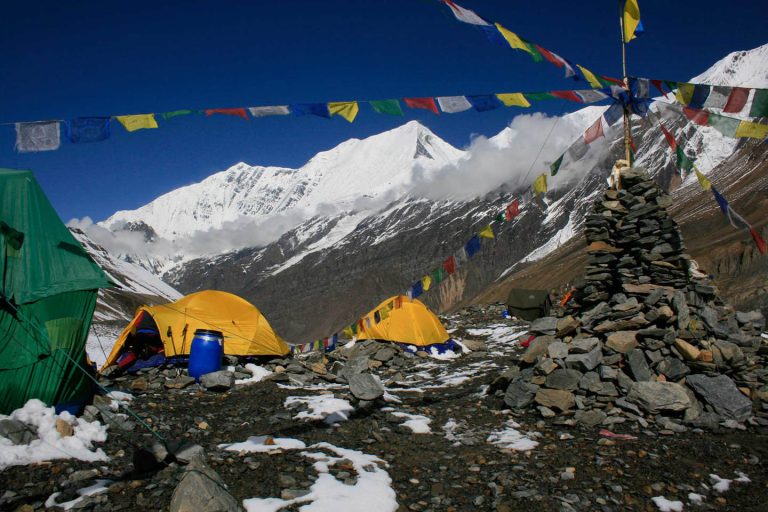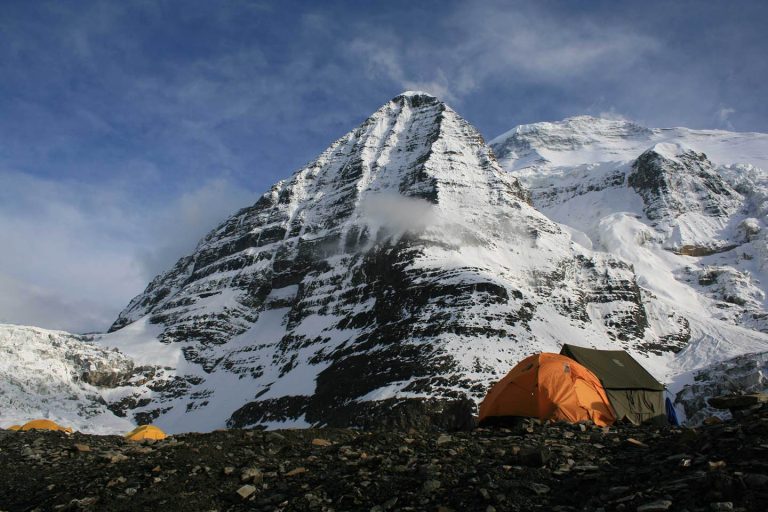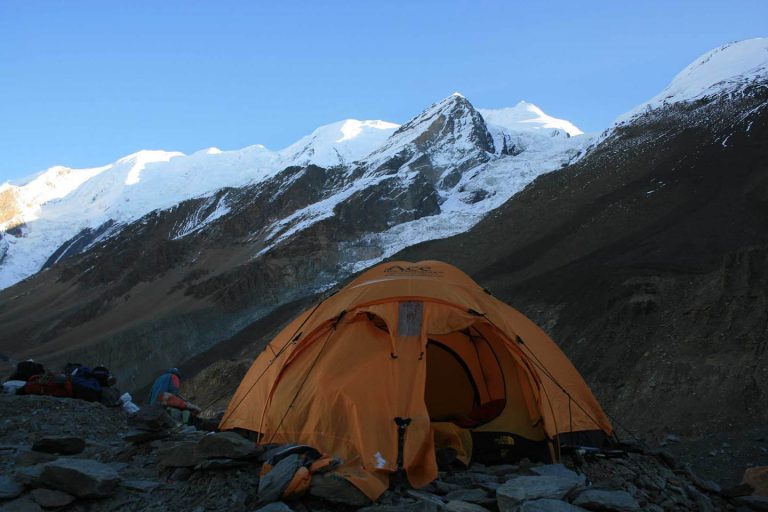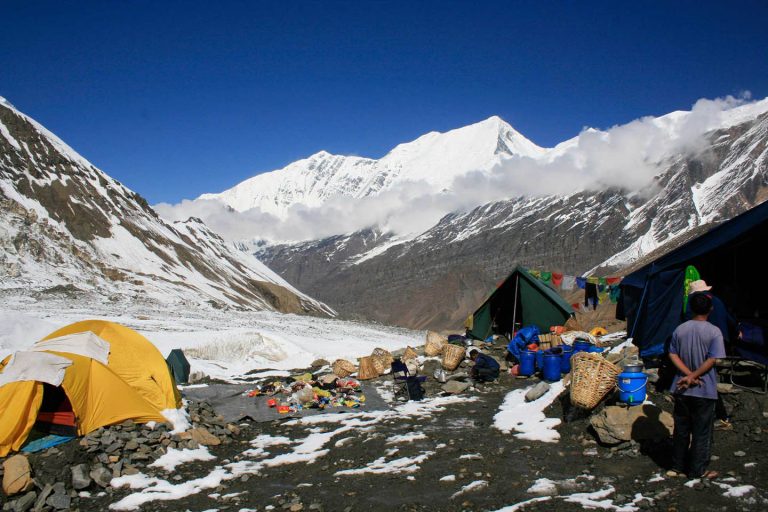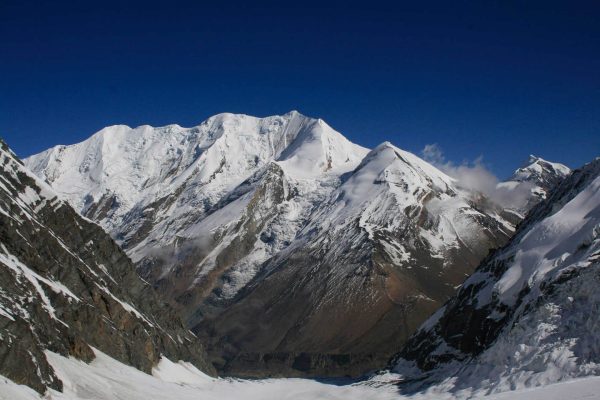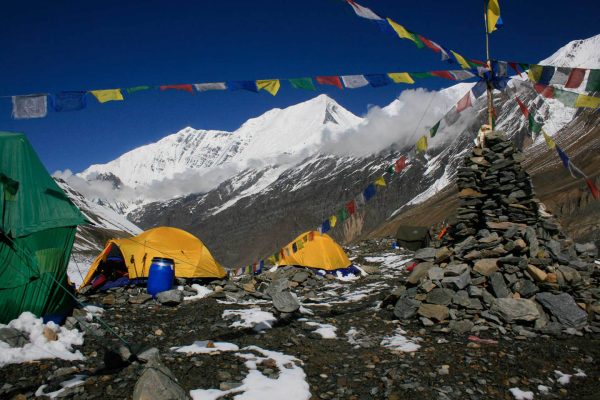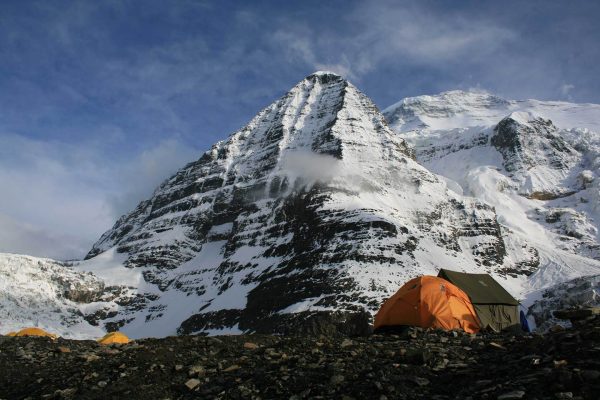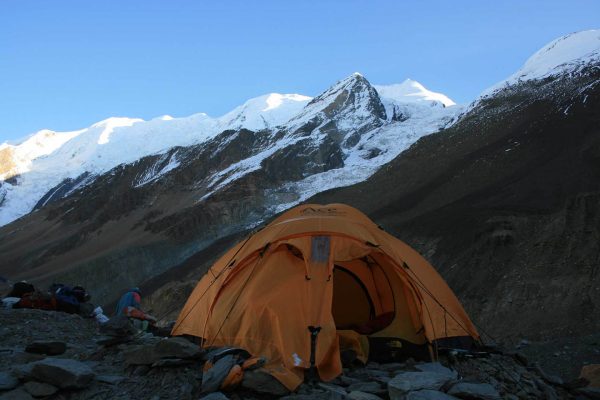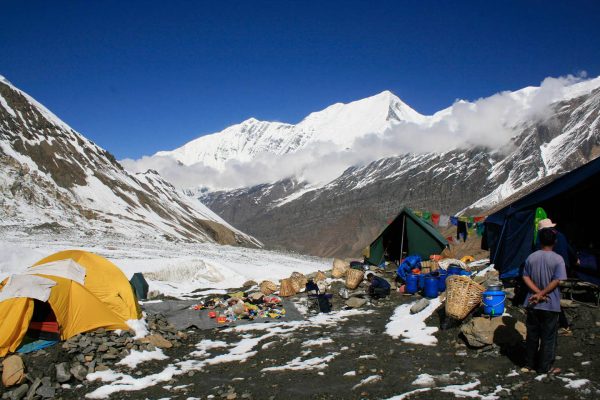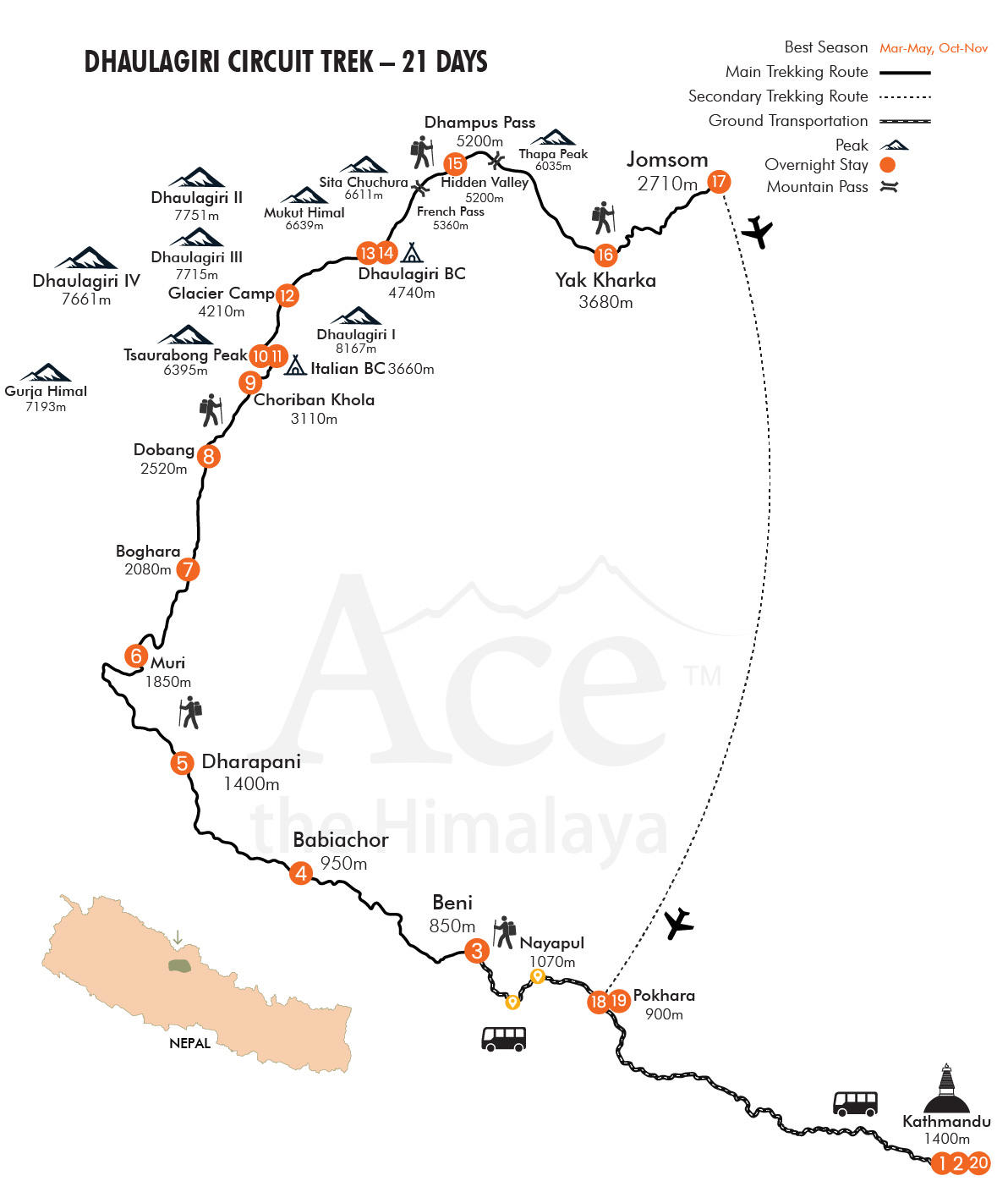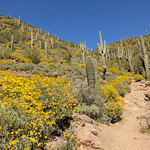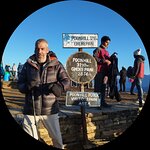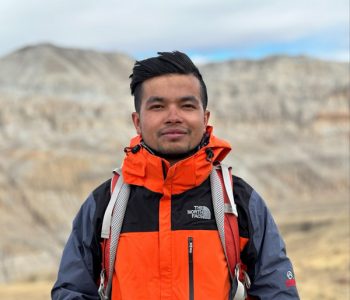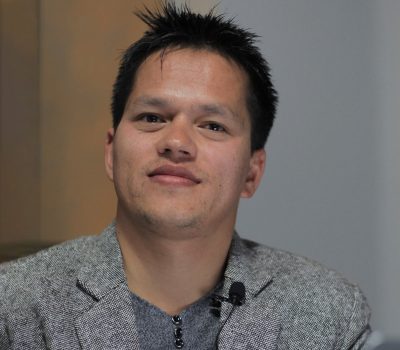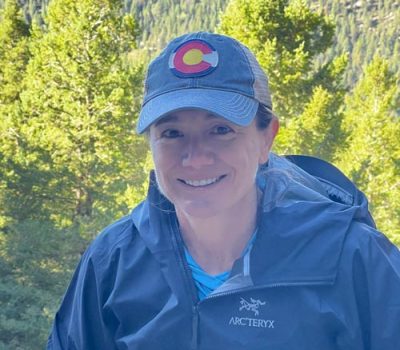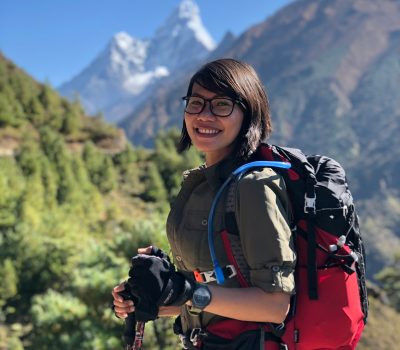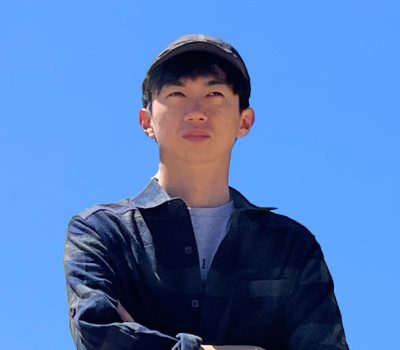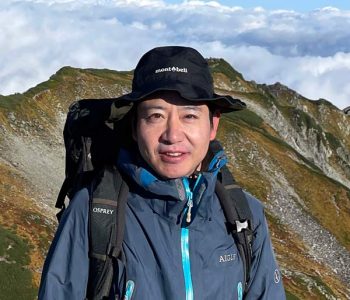Dhaulagiri Circuit Trek - 21 Days
Explore the alpine pastures, high passes, serene uninhabited valleys and the Himalayan Giants all through the Dhaulagiri Circuit Trek.
Trip Highlights
- Kathmandu and Pokhara city tour
- Scenic road drive to Beni
- Mur Magar village
- Dhaulagiri and Italian Base Camp
- French Pass Dhampus Pass and Hidden Valley
- Kaligandaki River Valley
- Scenic fly to Pokhara from Jomsom
Trip Overview
Dhaulagiri Circuit is a strenuous trek, through high alpine pastures, higher passes and serene and uninhabited valleys. Dhaulagiri 8,167 m – the 7th highest mountain in the world – means the “white mountain” though many mountains over the world have names, which translate to White Mountain. Everyone is familiar with the name Dhaulagiri which is in the western part of Nepal, probably the best spot for remote and adventurous trekking in Nepal. The simple reason behind it is that it consists of more than fifteen 7,000 m magnificent peaks with land of dramatic contrast.
Dhaulagiri Circuit trekking routes start after an 8-hour scenic drive from Kathmandu to Beni. From Beni you head in a north-westerly direction through the villages of Babichour, Dorbang and Darapani to Muri, from where you head north still keeping to the banks of the Myagdi Khola. Muri is the last major settlement along this trail and is inhabited by people of the Magar tribe, of Mongoloid stock and descended from the early settlers of the Nepalese middle hills. From Muri, you head north along the Myagdi Khola through the villages of Baghara, Dobang and Chartare to Pakoban.
Beyond Pakoban there are no permanent settlements. Still heading north you skirt the Chhanbardan Glacier, keeping on its left side, to reach the Dhaulagiri Base Camp from where magnificent mountain vistas are available. Head north-east from the Base Camp and climb the steep incline to the French Pass (5,360 m), between Tukche Peak (6,920 m) and Sita Chuchura (6,611 m).
Heading east you descend a little and pass through a portion of the Hidden Valley and climb to Thapa Pass (5,250 m), between Tukche Peak and Thapa Peak (6,012 m) from where you begin your descent, heading south-east to Alubari. From Alubari, the trail further descends to the village of Marpha on the banks of the Kali Gandaki River, and then heads north to Jomsom from where you fly back to Pokhara.
For those who have got enough time for Dhaulagiri circuit trek, there is an option of continuing to trek down to Kalopani, Tatopani, Ghorepani then into Pokhara.
Short Itinerary
Arrive in Kathmandu (1,400 m). Overnight at a Hotel.
Guided Sightseeing in the Kathmandu Valley. Overnight at a Hotel.
Drive to Beni (850 m) in a Public Bus – 8 hours. Overnight at a Tented Camp
Trek to Babiachor (950 m) – 5 hours. Overnight at a Tented Camp.
Trek to Dharapani (1,400 m) – 6 hours. Overnight at a Tented Camp.
Trek to Muri (1,850 m) – 5 hours. Overnight at a Tented Camp.
Trek to Boghara (2,080 m) – 6 hours. Overnight at a Tented Camp.
Trek to Dobang (2,520 m) – 5 hours. Overnight at a Tented Camp.
Trek to Choriban Khola (3,110 m) – 5 hours. Overnight at a Tented Camp.
Trek to Italian Base Camp (3,660 m) – 7 hours. Overnight at a Tented Camp.
Acclimatization Day. Overnight at a Tented Camp.
Trek to Glacier Camp (4,210 m) – 6 hours. Overnight at tented camp.
Trek to Dhaulagiri Base Camp (4,740 m) – 7 hours. Overnight at a Tented Camp.
Acclimatization Day. Overnight at a Tented Camp.
Cross French Pass (5,360 m) and Trek to Hidden Valley (5,200 m) – 6 hours. Overnight at a Tented Camp.
Cross Dhampus Pass (5,200 m) and Trek to Yak Kharka (3,680 m) – 6 hours. Overnight at a Tented Camp.
Trek to Jomsom (2,710 m) – 5 hours. Overnight at a Tented Camp.
Morning Flight to Pokhara – 30 minutes. Overnight at a Hotel.
Guided Sightseeing in Pokhara. Overnight at a Hotel.
Drive Back to Kathmandu (1,400 m) in a Tourist Bus. Overnight at a Hotel.
Transfer to the International Airport for Your Final Departure.
 Note
Note
Our standard itinerary might differ slightly due to unpredictable happenings and events out of our control. Factors such as flight cancellation/delay, unfavorable weather, natural calamities, newly implemented government rules, political affairs, trekkers’ health conditions, etc., are possible. Evaluating the situation’s possible solutions allow the trekking to resume as much as possible based on the best alternatives. In these times, we look for your cooperation and flexibility.
It is advised you arrive one day before the trip start date so you can rest, and it also gives you time to buy clothing, equipment, and gear required for the trek. Also, it is best if you book your flights with spare days in Nepal for this trek in case of any flight delays or cancellations. Moreover, you have options to customize this trip where you can add on a sightseeing tour in Kathmandu, Pokhara, other adventure sports, or day trips around the country before or after the trek.
 JOMSOM Flight Details: All you need to know!
JOMSOM Flight Details: All you need to know!
Twin Otter is the primary mode of transport from the airstrip at Jomsom. This service is pretty dependable. Sometimes, flights may be canceled due to mountain weather conditions or other technical problems. In such a case, Ace the Himalaya will organize the alternative available road transportation to ensure you are on schedule for your international flight. Likewise, for your two-way ground transportation between Pokhara and Jomsom, we use locally available vehicles, which are mostly Indian vehicles like the Mahendra Scorpio and Bolero. The expense of the road transport will be managed from the reimbursement received from the flight ticket after deducting the cancelation charge. So please note that there will be no refund of the flight from Jomsom to Pokhara if the alternative road transportation is consolidated.
Departures & Availability
We do not have fixed departure date for this trip. This trip can only be organized upon your request. There is an option of private and tailor-made journey best suited for you, your family and friends. We have price discounts according to the group size, the bigger your group, the bigger your group discounts. We allow complete flexibility on your departure date, please choose your preferable date.
Price Includes
- All (international and domestic) airport transfers on a tourist vehicle
Twin-sharing/double accommodation in a 3-star hotel for 2 nights each in Kathmandu and Pokhara including breakfast (Private room accommodation can be organized at an extra cost)
Tented camp accommodation and equipment during the trek. (We will provide fully waterproof two men tents, dining tents, kitchen gear, dining table, chairs, toilet tents, shower tent etc. and Climbing rope to cross the Passess.)
- All your standard meals during the trek (Breakfast, Lunch, and Dinner) including one hot drink and seasonal fruits
- Experienced, first-aid trained, government licensed, English-speaking Ace the Himalaya's trekking guide
- Porters during the trek for carrying luggage (1 porter for every 2 clients)
Flight cost from Jomsom to Pokhara including airport departure taxes in Jomsom airport.
Surface transfer from and to Kathmandu(Local bus transfer from Ktm to Beni and Tourist Bus transfer from Pokhara to Ktm).
- Entry permits and fees for all temples, parks, monasteries, and cultural and historical sites.
- Wages, accommodation, meals, gear, insurance, and medications for all staff
- Filtered water in the trails using Water Filter or using water purification tablets
- 1 Ace the Himalaya’s duffel/kit bag, trekking map, sun hat, Buff (Neck Gaiter) and trip completion certificate
- A farewell dinner on the last night in Nepal
- All administrative expenses and government taxes
Price Excludes
- Meals (lunch and dinner) in Kathmandu
- International flight fare and airport departure tax
- Any beverages including bottled and boiled water
- Travel insurance along with high-altitude emergency evacuation coverage
- Tips to trekking staff and driver
- Nepal Entry Visa (Visa can be acquired easily after your arrival at Tribhuvan International Airport in Kathmandu with a fee of USD 50 for 30 days visa and USD 125 for 90 days visa)
- Personal Trekking gear and equipment
- Any expenses other than the Price Include section
Detailed Itinerary
Expand AllDay 01: Arrive in Kathmandu
One of our officials will greet you at the Tribhuvan International Airport, Kathmandu, upon your arrival. We will take you to the hotel in our private tourist vehicle. Pre-trip meeting at the office with our trekking guide in the afternoon.
Note: If you arrive after 4 pm, there will be a briefing about the trip with our guide. It will be a short pre-trip meeting. Make sure to confirm your queries about trekking in the mountains. If you arrive before 4 pm, a pre-trip meeting will be organized at our office on the same day. Meet and greet with our trip guide. Prepare your luggage for the trek.
Be sure to bring the following documents to the meeting; two copies of passport-sized photos and a readable copy of your travel insurance policy. These documents help to acquire trekking permits and related documentation during the trek. Pay the remaining balance of your invoice and sign in the legally binding trip form and non-liability disclaimer.
Day 02: Guided Sightseeing in Kathmandu Valley
After a hearty breakfast, at 8.30 am your sightseeing trip will start. You will have a private vehicle and a professional tour guide at your disposal. Today we will visit some heritages listed below:
Pashupatinath Temple:
Pashupatinath Temple is one of the most significant Hindu temples of Lord Shiva in the world, located on the banks of the Bagmati River. Though you are not allowed to go inside the temple as it is strictly for Hindus only, you can clearly see the temple and the activities from the eastern bank of the Bagmati River. It is a square two-tiered pagoda temple built on a single-tier plinth which is famous all over the world.
Boudhanath Stupa:
Boudhananath is one of the holiest Buddhist sites in Kathmandu. It was built in the 5th century with four pairs of eyes of Lord Buddha in four cardinal directions keeping an eternal watch over the people and their doings. You will find Buddhist pilgrims from Tibet going round the stupa spinning the prayer wheels.
Bhaktapur Durbar Square:
Visit the Bhaktapur Durbar Square, the Royal Residential Quarter of Bhupatindra Malla, famous five-storied temple of Nyatapola in Pagoda style Batsala temple, Bhairavnath temple, Duttatraya temple, Pujari Muth and Palace of 55 windows.
Day 03: Drive to Beni (850 m) in a Public Bus
After breakfast, you head to Beni by Local Bus. You’ll find most of the scenery is very enjoyable along the countryside. Beni is the district headquarters and has a police check post where your trekking permits will be examined. The town is at the confluence of the Myagdi Khola and the Kali Gandaki.
Day 04: Trek to Babiachor (950 m)
Leaving Beni and Kali Gandaki the trek heads west along the north bank of the Myagdi Khola through the village of Beni Mangalghat to Singa and Tatopani (hot springs). Crossing the bridge beyond the village to the south bank of the river, the trail makes a little half loop before crossing another bridge, near the village of Simalchour, back to the north bank from where it continues to the village of Babichor.
Day 05: Trek to Dharapani (1,400 m)
The valley widens and terraced hills develop on both sides of the river. The trail is fairly level and you pass the village of Shahashradhara, cross the Duk Khola and walk through fields arriving at Ratorunga. From here the valley narrows again and terraces disappear on either side of the river. Continue to the village of Dharapani.
Day 06: Trek to Muri (1,850 m)
After crossing the river to its West Bank as you leave Phedi, the trail starts climbing in earnest and there will be many switch-backs until you arrive at the ridge and the angle of ascent eases. Again the trail climbs steeply to the villages of Muri. Continue your trek to Sibang and Mattim. From here you continue up an incline to the snout of the ridge, descend to the Gatti Khola and reach Phalai Gaon (1,810 m). Cross the Dhara Khola to once again emerge on the west bank of the Myagdi Khola and then climb a ridge to the large Magar village of Muri.
Day 07: Trek to Boghara (2,080 m)
Descend a little, cross a stream and continue through terraced fields before climbing a ridge to reach the pass from where you can see Mt. Ghustung South (6,465 m). Descend to the Myagdi Khola and trek along its West Bank to the village of Naural from where you will climb a little before traversing a grassy hill and climbing a steep slope with switch-backs, then descend through a forest and terraced fields to Boghara (2,080 m).
Day 08: Trek to Dobang (2,520 m)
The trail first descends through terraced fields to a small ridge, then through a forest to Jyardan which is the most remote permanent settlement in this part. After the settlement a high winding path crosses a rocky area which then descends before climbing again to Lipshe where there is one single hut. The trail continues through a forest to Lapche Kharka and then climbs to the level area at Dobang.
Day 09: Trek to Choriban Khola (3,110 m)
After crossing a wooden bridge out of Dobang, the trail ascends a forested area. Soon the west face of Dhaulagiri I (8,167 m) becomes visible through breaks in the trees. Descend to the Myagdi Khola and cross via a wooden bridge to the east bank continue to Chartare. Passing through forests again, you cut across a rocky area and cross a stream to Choriban Khola.
Day 10: Trek to Italian Base Camp (3,660 m)
Follow a trail to the terminal moraine of the Chhonbarban Glacier and enter the glacier from the right. Tukche Peak (6,837 m) becomes visible straight ahead; at the far end while the impressive north flank of Dhaulagiri I (8,167 m) dominates the skyline to your right. After a short walk, you will reach Italian Base Camp (3,660 m), which is also the site of your camp for the night. To the west are the peaks of Dhaulagiri II (7,751 m), Dhaulagiri III (7,715 m) and Dhaulagiri V (7,618 m).
Day 11: Acclimatization Day
We will spend a day acclimatizing to the thinning of the air. It is recommended that your body acclimatizes to the high altitude and be adjusted for higher altitudes in the days to follow.
Day 12: Trek to Glacier Camp (4,210 m)
Set up early in the morning when the weather is expected to be clear. This Trail is prone to stone fall, which passes through a narrow gorge. Today we stay overnight near at glacier.
Day 13: Trek to Dhaulagiri Base Camp (4,740 m)
This is one of our adventurous days to Dhaulagiri base camp. From here you can look up at the impressive north face of Dhaulagiri I (8,167 m) dominating the skyline to your right. To the west are peaks of Dhaulagiri II (7,751 m), Dhaulagiri III (7,715 m) and Dhaulagiri V (7,618m). In front of you is the impressive icefall that descends from the north-east col.
Day 14: Acclimatization Day
Another day to take some rest and more importantly, acclimatize to the lower air pressure. Views from this place are superb and there is plenty to explore.
Day 15: Cross French Pass (5,360 m) and Trek to Hidden Valley (5,200 m)
After the glacier, you climb two terraced hills, the first of which runs along the glacier, then cuts across the mountain flank and the moraine you enter a gentle incline on the left from an ablation valley. Climb this gentle slope to the French Pass (5,360 m). A great vista opens up from the French Pass and you will be able to see Mukut Himal (6,328 m), Tashi Kang (6,386 m) and Sita Chuchura (6,611 m), all of which surround the Hidden Valley. To the south is Tukche Peak (6,920 m) and beyond is the massive peak of Dhaulagiri I. From the French Pass you continue along the right edge of the Hidden valley losing a little altitude to the Thapa Pass (5,250 m) between Tukche Peak and Thapa Peak (6,012 m). Descending from the Thapa Pass you will make it to the camp at 5,200 m.
Day 16: Cross Dhampus Pass (5,200 m) and Trek to Yak Kharka (3,680 m)
Descend from the Hidden Valley to the Dhampus Pass and continue to Yak Kharka. There is a perfect campsite to enjoy the surroundings.
Day 17: Trek to Jomsom (2,710 m)
Continue on to the village of Marpha, on the west bank of the Kali Gandaki River. Marpha is home to many apple orchards as well as all various food products made from the fruit. Don’t forget to taste the local Apple Brandy a specialty from the region that you may be lucky enough to taste en route. Continue north, up the river valley to the town of Jomsom.
Day 18: Morning Flight to Pokhara
A 30-minute morning flight takes us to Pokhara from Jomsom. Once we arrive at Pokhara airport, we then drive to the hotel. In the afternoon we will have a sightseeing tour around Pokhara valley, which covers Fewa Lake, Devi’s waterfall, Museum, Tibetan refugee settlement and Gupteshower cave, etc.
Day 19: Guided Sightseeing in Pokhara
It’s also spare day in case of bad weather in Jomsom. If you are in Pokhara, you will do some sightseeing today.
Day 20: Drive Back to Kathmandu (1,400 m) in a Tourist Bus
You have the option to extend your trip to continue onto Chitwan jungle safari, rafting adventure, Kathmandu valley shopping tour, scenic Everest flight, mountain biking and other activities. In the evening we will have a farewell dinner in a traditional Nepalese restaurant with cultural dance performances. (Your guide(s) and an office staff will accompany you).
Day 21: Transfer to the International Airport for Your Final Departure
The trip concludes today. Our Airport Representative will drop you at the international airport in Kathmandu for your flight departure from Nepal.
Gears and Equipment
Here is a list of what you might want to pack for the hike. Please take this as a starting point. You’ll need layers of warmer clothing during the winter. We provide a 75 liter duffel bag for you to use for the trek. It will be given to you during your pre-trip meeting in Kathmandu. The duffle bag is yours to keep. Also, you can rent sleeping bag and down jacket with us at the additional fee of USD 35 for each once you are in Kathmandu.
General
- Four-season (zero degree) sleeping bag (We have rental sleeping bags available for an additional USD 35)
- Puffy down jacket (We have rental jackets available for an additional USD 35)
- Daypack (35-45 liters recommended) with rain cover
- Sleeping bag liner
Upper Body
- Sun hat or cap (We'll provide you with a free Ace the Himalaya baseball cap.)
- Knitted hat/Beanie
- Headlamp
- Sunglasses
Torso
- Technical fabric base layer (light for warmer months, heavy for colder months)
- Technical fabric short (2) and long sleeve (2) shirts
- Waterproof, windproof shell
- Fleece jacket or pullover
Lower Body
- Technical fabric base layer (light for warmer months, heavy for colder months)
- Hiking pants (2)
- Comfortable pants for inside the teahouses
- Waterproof, windproof shell
- Hiking shorts
Hands
- Wool or technical fabric liner gloves
- Hard-shell outer gloves (insulated for colder months)
Feet
- Wool or technical fabric warm socks
- Hiking socks
- Liner socks (optional such as silk)
- Trekking/hiking boots (waterproof recommended)
- Ice Cleats /Micro Spikes (For trekking from November to March, it's recommended to include Ice Cleats/ Micro Spikes to prevent slipping on icy or wet surfaces.)
- Casual shoes
- Gaiters (lightweight for dust or heavy for snow in colder months)
Undergarments
Note: The quantity of each article of clothing can be adjusted to suit the preferences of each participant.
- Technical fabric/quick drying is best for underwear (opportunities to launder during the trip)
- Sports bras (women)
- Pajamas or sleeping clothes
First Aid Kits and Medications
- (Note: Guides carry medications and first aid kits during the trip. However, personal kits and medications are highly recommended.)
- Sunscreen
- Lip balm
- ointment
Other Essentials
- Passport
- Extra copies of passport-sized photos
- Reusable water bottle
- Toiletry kits
- Water purification tablets or UV water purifier (if you plan to treat water)
- Hydration bladder
- Towel
- Pillowcase
- Toilet paper (2 rolls)
- High protein snacks (such as protein bars or nuts)
- Waterproof/dry bags for carrying important documents and money
- Airline tickets (Please leave a copy at our office in Kathmandu. This can be useful if there is a change in the date of the flight.)
Optional
Once in Nepal, if you have the time, you can purchase supplies and gear for hiking. Thamel, Kathmandu’s tourist hub, is home to many shops where you can get a variety of reasonably priced trekking equipment.
- Power bank or extra batteries
- Cameras and mobile phone
- Cards/book
- Binoculars
- Trekking poles
- Whistle
- Thermos for hot water
Important Information
- We give you a free duffel bag and baseball cap during your pre-trip meeting in Kathmandu. The duffel bag will be used to pack your trekking supplies.
- For every two participants, we assign one porter. The duffel bag, which should weigh around10 kg/22 lbs, will be carried by the porter throughout the walk.
- To carry your daily necessities like cash, crucial papers, a water bottle or bladder, a camera, toiletries, sunscreen, a notebook, clothing, etc., you must have your own daypack (with a waterproof cover).
- You can store your luggage (non-trekking items) at the hotel in Kathmandu.
- Down jacket with a hood is a must for altitudes above 4,000 m to keep warm. You can rent a down jacket for USD 35. Please note that in case of loss or damage, you need to reimburse the cost of USD 100 per item.
- You can rent a 4-season sleeping bag for USD 35. Please note that in case of loss or damage, you need to reimburse the cost of USD 100 per item.
Note: Some clothing, especially form-fitting, figure-hugging items made of elastic material (like yoga pants), may offend locals. Therefore, if you choose to wear these clothes for comfort, please make sure to wear something over them.
Trip Video
FAQs for Dhaulagiri Circuit Trek
General
Why trek with Ace the Himalaya?
Ace has a reputation for successfully leading treks with knowledgeable leaders and staff taking care of all your travel needs. We are a certified sustainable travel company that also endorses the idea of giving back to the community by participating in various philanthropic activities. Here are 17 reasons why you should choose Ace the Himalaya for your next adventure!
Is Nepal open to travelers following the Covid-19 pandemic?
Indeed, Nepal is entirely open. Travelers are welcome in Nepal without any restrictions. Arriving travelers can obtain a visa on arrival at the Kathmandu airport as well.
What are the conditions to travel to Nepal post Covid-19?
Traveling to Nepal is now hassle-free. You don’t need a vaccination certificate or negative PCR test, but check with your airlines and transit countries for any specific requirements.
We suggest you look at the Nepal immigration site https://www.immigration.gov.np for the most up-to-date information.
What additional documents do I need?
- Two passport-sized photos (2×2 inch) to give to our office staff
- A copy of your international flight ticket to give to our office staff
- A copy of travel insurance to give to our office staff
What should I know about booking my flights to/from Nepal? Do I need to plan extra days in case of delays?
The best course of action is to add a day or two before and after your intended trek days in case of flight delays or cancellations. It also gives you time to buy clothing equipment and gear required before your trip.
Please be aware that Ace the Himalaya is not responsible for any inconveniences or missed international flights resulting from unforeseen events like airport changes, flight delays or cancellations, etc.
Is hiring a guide necessary even if I have trekking experience?
It is highly recommended you do this trip with a guide. A guide is there to assist you in going forward and making alternative plans and arrangements when unanticipated occurrences happen or when things get difficult. Our hiking leaders are qualified experts.
Can the guide speak English?
Our guides are fluent in English. All the guides that we assign speak and understand English. They’ll share with you the fascinating stories, traditions, and folklore of the mountains. The guides will also help you communicate with the locals since many shopkeepers and hosts of teahouses don’t speak English.
Weather and Temperature
What is the best season for this trek?
The best seasons to do this trek are autumn (Mid-September to November) and spring (March to early June). This trek is possible year-round, and we can organize it when it suits your schedule. However, we generally suggest doing this trek in the favorable seasons and keeping away from the rainstorm season (July and August). In the cold months of January and February, the temperature can be a little harsh in the mountains. However, some prefer to travel during these months as it is less crowded given that you are well prepared with appropriate winter wear and other gear.
What kind of weather and temperature can I expect while trekking?
Due to its tendency to be localized, the weather in this region is challenging to forecast. You could see rain, fog, cold, or hot and sunny weather while trekking. It is best to be equipped to handle various weather situations. In the Everest region, nighttime temperatures are significantly lower than midday temperatures. In less than a day, the temperature can change from a high of 25°C (77°F) to a low of – 20°C (-4°F). The weather and temperature ranges are typically predictable based on the month and season, even though it might be challenging to predict what each day in the mountains will bring.
Spring – March/April/May/June
Despite being the busiest season, spring is perhaps the best time to visit the region. The many varieties of blossoming trees should be visible, and the sky should be clear with stunning vistas. During springtime, the average temperature is 20°C (68°F), with a high of 25°C (77°F) during clear days and a low of – 15°C (5°F) overnight above 4000 meters.
Monsoon season – July/August through Mid-September
Since it rains heavily at elevations below 3500 meters, this season isn’t exactly ideal for trekking. While it can occasionally be dry in areas above 4000 meters, it frequently rains so therefore not many people travel during this season. Trekking during the monsoon season has some advantages, such as a greater possibility of seeing waterfalls and the best opportunity to escape crowds. During the monsoon, the average temperature is 22°C (71.6°F), with a high of 30°C (86°F) during clear days and a low of- 5°C (23°F) overnight above 4000 meters.
Autumn – End of September/October/November
Autumn is equally as busy as spring. It is one of the best times to go, too. While the plants and trees are not in bloom, the sky is often clear, offering breathtaking vistas from almost every viewpoint. The average temperature in autumn is 17°C (62.6°F), with a high of 20°C (68°F) during clear days and a low of – 15°C (5°F) overnight above 4000 meters.
Winter – December/January/February
Due to fewer tourists, some people like winter travel. Even while the views are still beautiful, it can be cloudy, thus adding extra days is highly advised during this time. The average temperature is 10°C (50°F), with a high of 17°C (62.6°F) during clear days and a low of – 20°C (- 4°F) overnight above 4000 meters. The teahouses provide extra blankets for warmth at night.
What is the temperature rating of the sleeping bag that you lend to trekkers?
The temperature rating of the sleeping bags that we rent to trekkers is about -10°C (14°F). Also, our guides can obtain extra blankets if needed at the teahouses.
Arrival and Visas
Is it possible to obtain a visa for Nepal upon arrival at the airport?
Yes, you can obtain a Nepal visa upon your arrival at the airport. There are kiosks in the arrival hall that you use to complete the necessary forms. The cost is USD 30 for a 15-day tourist visa, including numerous entries, or USD 50 and USD 125 for a 30-day or 90-day tourist visa including numerous entries respectively. You should carry cash (USD) with you to pay your visa fees quickly and easily, as digital payments are frequently unavailable.
Who will come to pick me up at the airport upon my arrival?
Our staff will be waiting for you outside the airport terminal with our signboard (Ace the Himalaya). You will be accompanied to a hotel in a private tourist vehicle.
Payments and Extra Costs
How much additional money do I need per day?
Typically, USD 15 to 20 per person per day will be sufficient. This is to purchase water, tea/espresso, snacks, and hot showers in the mountains and for lunch or dinner in Kathmandu. Additionally, if you want to buy souvenirs or native Nepali goods, you can bring extra cash with you.
Is it possible to use credit cards in the places I visit during the trek?
Nepalese Rupees cash is preferred to credit cards while trekking in the mountain region. Exchanging your money into Nepali Rupees in Kathmandu before the beginning of the trek is ideal. This can be accomplished at the airport, banks, or at your hotel. Please note the hotels will exchange up to about USD 100 for each transaction only.
Is it possible to reserve a trip now and pay a deposit later, or do I have to pay a deposit at booking/reservation?
When you book, you must pay a 30% deposit to secure your itinerary. The remaining balance can be paid upon your arrival at Kathmandu or before arrival. US Dollars cash and credit cards (Visa, Master, and American Express) are accepted once in Nepal. Please note a 4% transaction fee will be added for all credit card transactions.
How do I pay the remainder of my balance upon arrival in Kathmandu? US Dollars cash or credit card?
You can make payments via US Dollars cash or credit card (Visa, Master, and American Express). A 4% transaction fee is added if paying with a credit card. Thus, we encourage you to pay with USD cash if you are planning to pay upon your arrival in Kathmandu.
We prefer you pay with larger bills (USD 50 or 100). Please note that the cash should not be older than 2009 and in good condition, as banks do not accept worn, torn, or crumpled bills.
How are the ATM and money exchange facilities in Kathmandu?
There are ATM and money exchange facilities almost every few meters in Thamel, where you will be staying in Kathmandu. So, you can easily use your cards to cash out limited sum of money to which a minimum charge is deducted by the ATM facility itself. You can easily exchange your foreign currencies in currency exchange centers for an exact rate.
Who Can Trek?
Do I need prior trekking experience?
Previous trekking experience is not required if you are physically healthy and have enough enthusiasm for the trek.
Are there any age requirements for mountain trekking?
Our treks have no age restrictions if members are healthy and willing. We have had families with kids as young as 5 years do the treks along this region, and our oldest adventurers have been in their late 70s.
Is trekking to mountain regions safe for solo female travelers?
It is safe for a female to trek alone in Nepal. Nepal is usually regarded as a safe nation for female visitors traveling alone. It is entirely safe for a solo woman to trek with Ace the Himalaya on any of our treks.
Physical Fitness
How challenging is the trek?
This trek is more demanding than any of our other treks in Nepal. Crossing the high passes in this trek can be technical so, climbing rope may be required in presence of heavy snow. You need good stamina for a long day effort while crossing the high passes in this trek. The knowledge of using a climbing rope and other equipment would be beneficial although not mandatory because our guide will provide you with the necessary training on using climbing gears such as ropes, ice picks, and crampons.
How quickly do you walk on the trail?
The average walking speed for a reasonably fit person is 4 kilometers per hour. At higher elevations, it is highly recommended that you walk slowly to help with acclimatization.
What kind of physical training is necessary for trek preparation?
To prepare for a strenuous trek you should begin training at least three to four months before your departure. As a guideline, an hour of aerobic exercise three to four times per week would be considered a minimum requirement. The best preparation is bushwalking involving relatively steep ascents and descents. If you can manage a couple of valley floors to ridgeline ascents per comfortable and able to enjoy the trek to the fullest. There is something about a trek in the Himalayas that draws you back time and time again. For keen walkers, it is a paradise and even avowed non-walkers find that one foot just seems to follow the other, drawn by the appeal of what lies beyond.
What are the physical standards that I need for the trek?
Participants in good physical condition should be able to complete this trek. If you are not physically active, we advise starting an exercise regimen two months before the trek that includes at least an hour of walking at an incline, running, or biking four to five times a week.
Incorporating hiking into your workouts is ideal. It is advised to speak with a doctor before making travel arrangements if you have any health conditions that could affect your ability to complete the trek.
Trek Preparation and Packing
What are the procedures after I make my deposit?
After making the deposit, one of our staff will email you for further information. We will require a copy of your passport photo page and your arrival/departure flight details. We will also provide you with additional trip information.
What sort of insurance do I need? How can I obtain a policy?
Travel insurance is mandatory for our hiking itineraries. We require your policy have medical evacuation coverage for the maximum elevation of your itinerary. Insurance may also cover additional costs in the event of a flight delay or cancellation caused by bad weather, medical costs, theft, loss, and damage to your items while traveling.
Travel insurance can be obtained online by one of several travel insurance companies. Please note that insurance obtained from an airline at the time of booking your flight may not cover medical evacuation coverage.
What are the necessary items that I should pack for my trip?
You can find the necessary items to pack for the trek on the Equipment tab. Gear and equipment can be bought or rented upon your arrival in Kathmandu. If you plan on buying or renting gear in Kathmandu, please allow extra time.
Do you provide sleeping bags or down jackets for rent?
Yes, we do provide sleeping bags or down jackets for rental costs of USD 35 each. Do let us know before initiating the trek and we shall provide items.
What type of bag will the porters carry?
We provide you with a free duffel bag of 70 to 80-liter capacity that our porters will carry. The maximum weight that porters can safely carry is 30kg, and each porter is assigned to two people.
What type of daypack should I bring?
We suggest a 30 to 40-liter capacity daypack. Wider straps and hip belts are recommended to assist you in carrying weight evenly and reduce pain.
What about my passport, medications, and belongings?
Bring copies of your passport, insurance papers, and other essential items in your carry-on during your flight. If you need to take medications daily, keep them in your daypack with your other essential possessions. You can store other non-trekking essentials in the office of Ace the Himalaya or at the hotel in Kathmandu.
Accommodation
What kind of lodging is available in Kathmandu and on the trek?
We use standard rooms at three-star hotels in Kathmandu and Pokhara with breakfast included.
Along the trekking routes, we provide the best possible camping service complete with comfortable two-person tents with good mattresses. A kitchen, dining, shower, toilet tents, and chairs with tables are also provided. Refer to the equipment list for items you will need to bring. We usually camp in or near a village, which allows you to buy sweets and drinks, which we do not carry with us. You will also get a small bucket of hot water each morning in your tent for a quick scrub-up.
For the night spending in camping, shared tented accommodation is provided (Two people in each tent). You can book a private tent by paying an additional cost of USD 400 for those nights you spend camping.
Is it possible to have private rooms while trekking or while in Kathmandu?
A private room in the teahouses cannot be guaranteed during peak season. During the non-peak season, the teahouses may provide a private room without any additional cost. The accommodation during the trek will remain very basic with twin sharing rooms and occasionally dormitory rooms for our trekkers.
We can arrange for a private room while in Kathmandu for an additional cost of USD 35 per room per night.
What happens if I end up staying an extra night/s in Kathmandu due to an unforeseen delay or cancelation?
In case of unforeseen circumstances such as flight cancellation, your health, or for any reason you decide to discontinue the trip and arrive early in Kathmandu then you will need extra accommodations in Kathmandu. The cost of the teahouses in the mountains is not equivalent to the cost of a hotel in Kathmandu. In such cases, we will arrange your accommodations, but you will need to pay a supplemental charge.
Is it necessary to bring toilet paper for the trek?
You can buy toilet paper in the guesthouses during the trek, but it can be expensive, so we suggest you bring some with you. You also need to bring personal items such as towels, soap, hand sanitizers, and so on.
Are there restrooms along the trail?
There are toilet facilities in the teahouses/lodges during the trek. Trekkers can also find private areas along the trail for emergencies.
What sort of food can I expect in trekking?
There are lots of good restaurants in Kathmandu and Pokhara where you can find any delight of your choice like local, continental, Chinese, etc., and can choose the best option for yourself from the menu.
During the camping, our expert camping cook will prepare normal and special meals upon request. The food is very healthy and safe and one can eat without any hesitation.
I'm a vegetarian. Is that a problem?
Most of the teahouses in the mountains offer vegetarian meals. So, being a vegetarian is not a problem. Vegetarian meals are preferable to avoid food poisoning and indigestion.
Is the water okay to drink? Do I need to bring purifying tablets or filters?
Natural spring water or tap water can be found along the trek and in guesthouses but must be treated. We use Katadyn filters to purify the natural water sources to make them safe to drink. This way, it is sustainable and pocket friendly as you need not buy bottled mineral water. You must carry a water bottle that can hold both hot and cold water and a hydration pack.
If the temperature drops too low for the Katadyn filter to function properly or if any technical issues occur, it is recommended to buy boiled water from the teahouse to ensure safe drinking water as an alternative.
Can we get hot or boiled drinking water? Does it cost extra?
Yes, teahouses do provide hot boiled water for an extra charge of USD 2 to 5 per liter. The cost varies and increases at higher altitudes.
Can I shower/bathe during the trek?
As it is a fully camped trek, showers can be a little hard to manage. You can however shower once you are back at your hotel in Pokhara and Kathmandu.
Can I charge my electronic equipment during the trek?
You can charge your equipment while at Pokhara. During camping, you might have to rely on backup power, so it is not a guarantee. It is suggested you carry portable power banks and such along with two pins (type C) and three pins (type D) adaptors. Bring these adaptors or purchase them while you are in Kathmandu.
Health and Safety
Do your guides have the trekking guide certificates from the Hotel Management and Tourism Center? Have they received first aid training for high altitudes?
We provide licensed trekking guides with fluent English. Our guides are certified by the Hotel Management and Tourism Center after receiving 45 days of training. Similarly, the guides receive high-altitude training from Kathmandu Environmental Education Project (KEEP).
What are safety measures in place? What safety equipment do your guides carry on the trek to deal with sickness/accidents?
Our guides are well trained and certified in first aid. Throughout the journey, our guides will evaluate your condition and your oxygen level using an oximeter. Our head office receives continuous updates on your condition and location through the guides. In places without a phone signal, your situation will be updated through a satellite phone during emergencies.
How do you allocate guides and porters in a group?
We allocate one guide for groups of up to 8 participants. For groups of over 8 participants, we allot an associate guide. As per the size of the group, we may add more guides or divide them into sub-groups.
We provide one porter for every two clients. Two clients’ duffel bags will be carried by one porter. The weight limit is 30kg or 15kg for each client. For an additional cost, we can arrange for one porter to carry one participant’s duffel.
Is Ace the Himalaya's staff insured?
Our company insures all our trekking staff members, including guides, cooks, Sherpa, and porters. Please browse through our legal docment page to view insurance details.
What vaccinations will I need?
- Typhoid vaccination is recommended but not required
We suggest you have a dental checkup before your trip and know your blood type. It is helpful if you inform us of any medical condition that is relevant so we may convey this information in the event of an emergency. Ace the Himalaya keeps your medical condition confidential unless treatment is necessary.
What if I am very sick in the mountain?
Our guides are 24 hours available for the services during the trek. They are trained to use first aid kit and have knowledge to use Oxy meter. They are very much aware that higher the altitude the oxygen level gets lesser so to get updated on the oxygen level of our client and to know whether they are fit enough or needs extra precautions to continue.
Guides carry local sim cards both Nepal Telecom and Ncell in order to update whereabouts and situation of our every client. During the time of emergency our guides are alert and keeps updated to head office in Kathmandu that is available 24 /7 to arranging from horse to mules or helicopters in the must needed cases especially when client is seriously sick in the mountain and needed to be hospitalized.
Do you guys have a PAC (Portable Altitude Chamber)?
Yes, we have access to a portable altitude chamber in case of an emergency. It is not essential to carry during the trek. Though, we can use arrange it upon request for an extra cost of USD 200.
Do you provide oxygen supply if needed?
The cost of oxygen can be high so we recommend having travel insurance so they can reimburse you. We can provide pre-booked oxygen for an extra cost of USD 150 for 1 tank that can be carried along with you during the trek.
How are acclimatization and altitude related?
Altitude sickness is a possibility during the Dhaulagiri Circuit trek. Air at higher elevations has less oxygen available. To avoid altitude sickness, acclimatization days and slow climbs are recommended at higher elevations. Along the trek, you’ll be assisted by our professional guides in recognizing and preventing altitude sickness.
What kind of trekking boot would be best for the trek?
An important piece of equipment is your trekking boots. Invest in a durable and comfortable pair, preferably with water-proof lining. Boots that provide ankle support on rough ground and have stiff soles are recommended.
What is necessary for sun protection during the trek?
Even when the sun isn’t shining, sun protection is essential. UV rays are reflected by the snow and the harshness of the sun will damage your skin before you notice it at high elevations. Therefore, proper clothing and sunblock are necessary. Hat, sunscreen, sunglasses, clothes, etc. are vital for sun protection.
Practical Matters
What is your cancellation policy?
Notice should be provided 20 days before the trip start date in case of cancellation. The trip can be canceled for justifiable reasons. Once the trip is canceled, a fee of 30% of the trip cost is retained for administrative costs.
However, the trip amount is entirely non-refundable if the cancellation is not made before the 20 days as per our terms and conditions. For submitting a claim to your insurance company after the cancellation, we can assist with documentation such as a receipt of monies paid. Refund will not be provided for unused accommodation in case of trip cancellation caused by personal reasons/sickness/weather.
More information about our cancellation policy can be found here in Terms and Conditions page.
Do I need to tip my guide and porter? How much would that be?
Tipping is expected and appreciated. You can tip your trekking guides and porters based on your satisfaction and enjoyment. We suggest you spend at least 10% of your total trek cost for tipping staff. You’ll learn more about how much to tip your group’s guides and porters during our pre-trip briefing in Kathmandu.
Is there any communication while we are trekking?
Yes. The guides carry local cell phones, so you can use their cell phones if necessary and reimburse them. Assuming you have brought your cell phone, you can obtain a local SIM card and use it. Our guides or representatives can help you get a local SIM card after your arrival. There is the availability of Wi-Fi at most teahouses for an additional cost. We utilize satellite telephones for emergencies.
Does it cost an extra amount if I am a solo traveler?
If you are a solo traveler and book one of our published dates, there is no additional fee. If you sign up for a private trip or change the trip date from one of our published trip dates, you will be charged an additional fee.
Is there a provision for a refund policy if I don't accomplish the trek?
Trekkers occasionally fail to complete the journey for medical or personal reasons. In this situation, be aware that we do not issue any refunds for products purchased or unused trek days. We must pay our administration staffs, guides, and porters, purchase trekking permits, and all other booked accommodations in advance, so our expenses remain the same.
Who else will be joining my trekking group?
If there are any, you will be allocated to a trekking group. The details of the personal data of your group members cannot be disclosed. However, feel free to contact us if you have queries about other trekkers in the group and we shall give you a general idea of the ages, nationality, and sex of your group members. Chances are you will be trekking with others unless you have booked a private trip.
Can I add extra days to my trekking trip?
You can extend your trekking trip for an additional cost. Potential arrangements will be made if we get a request from your guide. This is applicable for private or solo trips as the itinerary can be easily adjusted. The addition of extra days is bound by time when you are in a group. Therefore, discuss with your group and guide, what changes can possibly be made.
I want to extend my holiday, any recommendations?
Yes, you can extend your holiday. Ace the Himalaya offers many options and alternatives for your holiday extension. For more information, you can visit our Day trips pages.
Transportation and Flights
Do I need to book my international flights for the travel to Nepal?
Yes, you must book your international flights. We are a local agency and do not make international flight arrangements. You can easily browse through flight tickets in airlines sites to book ones most feasible for you.
What form of transportation do you utilize?
We utilize tourist vehicles for touring, city visits, and airport pickups. Based on the group size, we use cars, minibusses, or vans. We use 4WD SUVs when necessary. For domestic flights, we use Sita Air, Tara Air, and Summit Air.
What is the alternative optiontion if my flight from Jomsom to Pokhara is canceled or delayed?
Twin Otter and Dornier is the primary mode of transport from the airstrip at Jomsom. This service is fairly dependable. Sometimes, flights (from Jomsom) may be canceled due to mountain weather conditions or technical issues.
In such case, as an alternative, you need to travel by road by local bus or jeep and our guide can help you to arrange this service. Our guide will let you know the extra cost at that moment if any is applicable. However, if you have extra days and you don’t want to make road transportation then we will reschedule your flight for the next day if possible.
Please note: Road transportation from Jomsom to Pokhara is not very comfortable and it takes more than 10 hours of your journey.
Traveler Reviews
These full and frank reviews are from travelers who have traveled with Ace the Himalaya previously. The reviews and experiences shown here are from reputable travel websites like TripAdvisor, Google, Facebook, and Trust Pilot, etc.
 Google Reviews
Google Reviews
What makes this trip different ?
Our CSR with Sambhav Nepal
- Ace the Himalaya believes in giving back to the communities that surround and support tourism in Nepal. Ace provides logistical support and, if needed, cash donations to the projects of Sambhav Nepal (a local NGO).
- Sambhav Nepal and Ace work together to plan volunteer programs that will bring in foreign volunteers and make use of their enthusiasm, time, and talents in a variety of projects.
Sustainability and Responsible Tourism
- Of the few Travelife Partners in Nepal, Ace the Himalaya is one. We respect the procedures for sustainable tourism. Our excursions are socially and environmentally conscious, leaving the lowest possible impact in the Himalayas.
- About 80% of Ace the Himalaya’s staff members are natives of the regions where our trips are organized. It is one of our sustainable and responsible efforts to help local communities, support small businesses, and promote regional culture and way of life.
